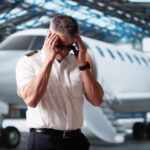Spatial Disorientation and How to Help Reduce or Avoid It
Spatial disorientation is a crucial safety issue for pilots, as it can lead to catastrophic consequences if not addressed. Spatial orientation is the ability of a pilot to maintain their awareness of their position and movement relative to the environment around them. If a pilot becomes spatially disoriented, they may be unable to correctly interpret the terrain surrounding their aircraft, leading to a loss of control and potentially hazardous consequences.
Spatial orientation is a critical skill for every pilot, regardless of their experience level. To help prevent spatial disorientation, pilots must become aware of the various factors that can contribute to its onset. These include incorrect instrument readings, optical illusions caused by clouds or terrain features, unfamiliar surroundings due to flying over new areas or at night, and physiological changes in the body due to fatigue or pressure changes.
When flying, spatial orientation means reading and understanding navigational instruments, interpreting terrain features and visual cues, and being aware of any changes in altitude or attitude. This information helps pilots orient themselves to where they are going and makes it easier to stay on course while navigating challenging environments.
Pilots may become unaware of their aircraft’s location or lack knowledge of the surrounding terrain when spatial disorientation occurs. This can lead to losing control if not addressed promptly, resulting in potentially hazardous consequences such as mid-air collisions or crashes. Therefore, pilots need to remain vigilant and knowledgeable about their spatial orientation to ensure the safety of themselves and others around them.
Factors That Lead to Spatial Disorientation
Various factors can contribute to a pilot becoming spatially disoriented while flying. These include incorrect instrument readings, optical illusions caused by clouds or terrain features, unfamiliar surroundings due to flying over new areas or at night, and physiological changes in the body due to fatigue or pressure changes.
Instrument failure is one of the most common causes of spatial disorientation, as it can be difficult for pilots to interpret their environment accurately if their instruments are not functioning correctly. Additionally, flying in environments with low visibility, such as during nighttime flights or when surrounded by clouds, can lead to optical illusions, which may cause confusion and loss of orientation. Finally, fatigue and pressure changes in the body from high-altitude flight can impair a pilot’s ability to remain oriented, leading to spatial disorientation.
Dangers of Spatial Disorientation
The dangers of spatial disorientation include:
- Loss of control: Spatial disorientation can cause the pilot to lose control of the aircraft, leading to potentially fatal consequences.
- Inaccurate perception: The pilot’s brain may perceive the aircraft’s orientation differently than it actually is, leading to incorrect actions and decisions.
- Confusion: Spatial disorientation can cause confusion in the pilot’s mind, making it difficult to determine which way is up or down.
- Disorientation: Pilots experiencing spatial disorientation may become completely disoriented and lose their sense of direction entirely.
- Vertigo: Pilots may experience vertigo, a sensation that they are spinning or moving when they are not. This can lead to loss of balance and coordination.
- Reduced situational awareness: When experiencing spatial disorientation, pilots’ attention may be focused on their own sensations rather than external factors such as air traffic or weather conditions. This can reduce situational awareness and increase the risk of accidents.
It’s important for pilots to be aware of these dangers and take steps to prevent spatial disorientation, such as relying on instruments rather than their senses in certain situations.
Preventing Spatial Disorientation
In order to prevent spatial disorientation from occurring while flying, pilots should follow several safety practices and procedures, including.
- Staying current with training: Regular training in instrument flying and spatial orientation can help pilots maintain proficiency and reduce the risk of disorientation.
- Avoiding hazardous weather conditions: Weather conditions such as fog, low clouds, or thunderstorms can increase the risk of spatial disorientation. VFR-only pilots should avoid flying in these conditions whenever possible.
- Using visual cues: Pilots can use visual cues such as the horizon or ground features to help maintain orientation. They should also be aware of illusions caused by certain lighting and atmospheric conditions.
- Managing workload: High workload situations can increase the risk of spatial disorientation. Pilots should manage their workload by prioritizing tasks and delegating responsibilities when appropriate.
Spatial orientation is an important safety issue for pilots to be aware of and understand. By thoroughly understanding their environment and the terrain around them, pilots can reduce the risk of disorientation occurring in mid-flight. Additionally, various safety practices should be followed, such as pre-flight checks, staying hydrated throughout the flight, avoiding unfamiliar areas and optical illusions, and taking breaks if necessary. With these precautions in mind, pilots can ensure a safe and successful flight experience.
At CTS, we believe spatial disorientation in flight can be prevented through preparation and education. We offer multiple subjects to help pilots avoid it, including our Flat-light, Whiteout, and Brownout Conditions, Controlled Flight into Terrain, and High Altitude Weather and Aerodynamics courses. We can also create a course tailored to your company’s specific operations. For more information on these courses and others, visit ctsys.com or email our team at train@www.ctsys.com.
RELATED READING
RELATED CTS TRAINING










